
19 minute read
INDUSTRY 4.0
The use of high performance standard CMOS sensors for 3D vision, detection and measurement
Overview
Advertisement
3D imaging technology appeared several decades ago but the first products were only commercialized in the 2000’s, when many big studio movies were released in 3D, using the latest HD video cameras. Since then, the field has evolved in leaps and bounds in terms of speed, accuracy and 3D imaging resolution and it has been extensively adopted not only in consumer markets but also in the machine vision industry.
With the Industry 4.0 revolution upon us, the need for 3D vision is increasing due to the limitations of 2D vision in terms of accuracy and distance measurement for complex object recognition, dimensioning and also limitations in complex interaction situations such as human/robot cohabitation.
3D vision increases the autonomy and effectiveness of robots/ machine systems in the factory automation market as it’s essential for higher accuracy quality inspection, reverse engineering and object dimensioning where 2D vision is limited. In addition, the use of visions system guided robotics is growing and requires 3D vision for better remote guidance, obstacle recognition and accurate moving. perspectives of an object, and calibration techniques are used to align pixel information between the cameras and extract depth information. This is similar to how our brains work to visually measure distance. • Structured light: A known light pattern is projected onto an object and depth information is calculated by the way the pattern is distorted around the object. • Laser triangulation: Laser triangulation systems enable 3-dimensional measurements to be captured by pairing a camera with a laser source. Due to a known angular offset between the laser and the camera, the system measures the geometrical offset of a laser line (whose value is related to the height of the object) using trigonometry. This technique is based on the scanning of the object. • Time-of-Flight: A light source is synchronized with an image sensor to calculate distance based on the time between the pulse of light and the reflected light back onto the sensor.
Each technique has its pros and cons and so, depending on the targeted applications (especially the distance range and the depth accuracy requirements), some are more suitable than others. A relative comparison is done in table 1.
3D vision also protects workers in factories from intensive human/machine interactions, with systems preventing and resolving dangerous situations, and with surveillance systems that are able to count and differentiate people from robots or objects.
3D vision is influencing society with its ability to make safer, better performing and more effective assistance systems for end-users. For instance, 3D vision is an enabler for advanced automotive assistance driver systems in autonomous vehicles, collaborative robots etc.
When considering scanning barcodes and OCR, 2D imaging is nevertheless here to stay. It plays an integral role in factories and warehouses, where its deployment is rising through block-chain adoption, as well as the e-commerce boom, which is driving spectacular growth in fulfilment centers and transportation. Teledyne e2v has unique 2D imaging products dedicated to code scanning such as the Snappy sensor family with performance and features to achieve high scanning rates and reliability.
Performances Stereo Vision Structured Light Laser Triangulation Time of Flight (ToF)
Rang
Depth accuracy
Response time
Software Complexity
Low-Light Performance
Bright-Light Performance
Changing Light Conditions
Compactness
Manufacturing & Calibration efforts
Material Cost
Field of view
Limrted (2m to 5m)
Could be improved by combining with a light source
Low (cm) Could be improved by combining with a light source
Short & Limited
Scalable (cm to 3-5m (cms to 1m) Scalable (<50cm to 20-50m)
High (µm to cm) Very high (µm) Medium (mm to cm)
Medium
High
Weak Slow
Medium Slow
High Fast
Low
Light source dependent (IR or visible) Light source dependent (IR or visible) Good (IR, laser, LED)
Good Medium Medium Good
Weak Medium Medium Good
Low Low Medium High
High High High Low
Low
Limited (fixed and calibrated) High/Medium High/Medium
Limited (fixed and calibrated)
Limited (fixed and calibrated) Medium
Scalable (large FoV possible, source, sensor resolution, distance dependent)
Several techniques and technologies exist in order to get a 3D image. The main ones are: • Stereo vision: Two cameras are used, mounted with different
Table 1. 3D Imaging techniques ‘top-level’ comparison
Although it still represents a small part of the vision systems used in factory automation and warehouses, currently more and more 3D systems are deployed based on 3D stereo vision, structured light cameras or laser displacement. These systems operate at fixed working distances and require significant calibration efforts for specific areas of detection. A Time-ofFlight system overcomes these challenges and gives more flexibility from an application point of view but most of them are still limited in image resolution.
Teledyne e2v has a track record of successes in machine vision, both in line scan cameras and area scan sensors, and is now building a unique platform dedicated to 3D imaging. This will support the latest industrial applications such as vision guided robotics, logistics automated guided vehicles (AGV), factory surveillance and safety, handheld scanners as well as outdoor applications. Teledyne e2v aims to provide a consistent offer based on several 3D techniques that will meet the applications requirements of the customer.
Beyond 2D, 3D vision for high speed and accurate inspection to increase productivity
Factories are automated to increase productivity and gain time and money in all the cycles of product inspection and inventory. In order optimize these factors, the machines including vision systems need to operate at higher speeds and with better performance.
Subsequently, whereas 2D vision is limited, 3D vision is extensively deployed for higher accuracy quality inspection, reverse engineering or object dimensioning.
The laser triangulation technique is commonly used in in these types of applications because of the high resolution required on the three axis, therefore demanding very high speed sensors.
3d Inspection Measuring shapes Volume Inspection (Logistics) Designed to enable easy and cost-effective integration for camera makers, the new sensors include a wide range of application-based features enabling high flexibility in use such as: ► High Dynamic Range modes with up to 100 dB that enables the measurement and inspection of both highlyreflective surfaces and dark areas in the same image through a HDR mode up to 100 dB ► Multiple Region of Interest mode that allows a perfect trade-off between profiling rate and range/resolution in the height measurement ► Frame to frame ‘hot’ changes mode of some parameters that enables flexibility and real-time adaptation to the environment conditions ► Different trigger modes that allow a perfect adaptation to the speed of production lines
The main benefits for the industrial market are: ► Higher production rate due to it providing the highest speed on the market with a 2k or 4K horizontal resolution ► Cost effective system : The Flash family provides the best value for money (best Gbps/price ratio in the market) ► High flexibility in use such as allowing a real-time adaptation to the environmental conditions and to the speed of the production lines
Beyond 2D, 3D vision to ease autonomy and effectiveness of factories
In order to improve the autonomy and effectiveness of factory automation, the use of autonomous guided robots is growing. As factories and warehouses become increasingly automated, working stations are intensively collaborative between humans and machines making prevention and safety are even more essential.
In such unpredictable working environments, Time-of-Flight (ToF) systems are ideal due to their real-time 3D information and decision capability and the ability to detect objects or people within fast scenes.
There are two methods when talking about the Time-of-Flight technique: direct Time-of-Flight and indirect Time-of-Flight.
Figure 1. Laser triangulation applications examples
For more than 10 years, Teledyne e2v has been working with market leaders in 3D laser triangulation and developing custom sensors. Last year Teledyne e2v launched a family of off-the-shelves sensors to meet the challenging demands of high speed volume measurement and inspection to comply with high speed production lines.
The Flash CMOS sensors outstandingly combine a resolution of 4,096 x 1,024 pixels and 2,048 x 1,024 pixels with a respective frame rate of 1800 fps and 1500 fps (8 bits) and a respective readout speed of 61.4 Gbps and 25.6 Gbps in a standard optical format (APS-like optics and C-Mount respectively). In the case of direct ToF, the system measures the distance by directly calculating the time it takes for the light to bounce off an object.
In the case of indirect ToF, the system measures the distance by calculating the phase differences of the light waves when they are emitted to the object and when they bounce back. This allows the system to build a 3D map.
Indirect ToF-Phase shift
Advantages • Full speed (with multiphase pixels) • Background subtraction, compatible with outdoor • Low software complexity

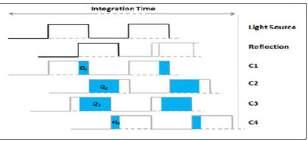
Direct ToF - Pulse reconstruction
Advantages • No aliasing • No wrong distance measurement (due to mist, dust, multipath reflections..)
Weaknesses • Tough speed specifications (light puses are ~ns) • Computational complexity relatively high

Figure 2. Pros and Cons of Direct ToF and Indirect ToF
Teledyne e2v offers solutions for both direct Time-of-Flight systems through custom sensors and indirect Time-of-Flight systems through a complete portfolio of standard products.
Teledyne e2v has been working for over 10 years on Time-ofFlight technologies and solutions and has strong capabilities with an innovative Time-of-Flight pixel, which is based on a track record of custom sensors developed for leaders in automation robotics automotive, and surveillance.
The key differentiators of our standard ToF sensors are listed below and these are what customers are seeking: ► High spatial resolution sensors enabling a large field of view coverage and high angular resolution ► Fast and real-time 3D detection without any motion blur and over 30fps depth map at full resolution ► Both short and mid, long distance detection and management ► Ultra-reliable distance measurement in any condition: excellent precision and robust to ambient light conditions and multiple systems operation
Time-of-Flight to handle complex environment operations
Compared to others 3D techniques, ToF system is fast, simple, inexpensive and has excellent 3D performances at mid and long range.
In addition, as previously mentioned, due to its highly flexible use – a ToF system could be mounted in a moving robot as the system doesn’t need to be calibrated depending on the setup (e.g. factory calibration). The system can also be adapted to any operational setup making a ToF system well suited to being operated in complex environments and conditions.
Below are some examples of factory and warehouse applications where Time-of-Flight is the best candidate.

Figure 3. ToF applications examples
► Measure the size and volume of a box or package: ToF imaging systems can measure the size and volume of a box/package in order to get the most efficient palletization or conditioning (packing and truckload optimization) or for efficient product lines. ► Goods identification for intelligent and efficient warehouse management: ToF imaging systems detect the goods or dimensions of a package in a shorter time than 2D conventional image processing ► Pick and place: ToF imaging system detect and identify the right object to be picked and placed, in the right position, with a very high level of accuracy and in shorter times than conventional 2D image processing
Compared to the current products in the market, the Bora sensor (introduced by Teledyne e2v last year) offers unique advantages for applications where the scene to be analyzed is static. With a high spatial resolution of 1.3MP, it captures a large scene with a wide field-of-view in both 2D and 3D, making a cost effective and optimized system. All of our ToF sensors are designed to be highly flexible and adapt to various operating conditions as well as providing real-time 3D image capture with a depth map and at high speeds of over 30 fps in full resolution in a four-phase operation. Some features and highlights of the Bora sensor: ► Innovative 10µm pixel design ► A spatial resolution of 1,280 x 1,024 pixels ► Excellent sensitivity and a unique on-chip gated global shutter mode, which enables gating times as fast as 42ns
Helping robots to navigate autonomously and safely in factory environment in another application where ToF systems are beneficial compared to other 3D techniques.
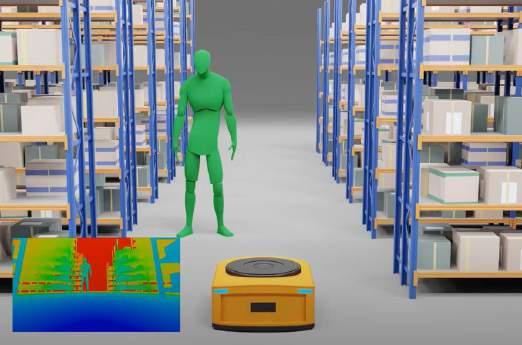
Figure 4. Robot navigation application’s example
Today, most navigation systems use a traditional Lidar scanner to detect objects but there are some cons and more and more solutions are emerging with alternatives technologies such as indirect ToF. Compared to the traditional Lidar scanner, indirect ToF systems provides real time image information with fast response times and no motion blur. They are also more robust and compact as no mechanical part is involved and cheaper since it’s a solid-state design using less power and less computation.
Range
Precision
Resolution
Speed
2D and 3D images
Motion blur/Motion artifacts removal
Field of view
Response time : 3D map
Compactness of the system
Robustness of the system
Robustness to the outdoor environment (changing-light, sunlight…)
Price
Parameters Traditional Lidar
Long (Up to 70m-100m)
Medium: Laser scanning, mm
Low
Slow: 20 fps
No: no image, coordinates reconstruction by computation
Indirect Time of Flight (ToF)
Scalable (Short distance: 30-50cm to 5m-10m; Long distance: >10m-100m)
Medium: mm, cm
Medium-High: Up to 1.3MP: 1280x1024 (state-of-the-art)
High: >60 fps for 3D depth map
Yes: 2D greyscale mage (CMOS sensors) + 3D Map
No:: one single point scanning of the object, may cause artifacts or miss the object
Large in horizontal (laser scanning up to 360°) Low in vertical
Low: Scanning before 3D reconstruction
Medium
Medium: mechanical parts
High Yes: capture of moving objects instantaneously (in one frame)
Medium: Can be large (> 120°) depending on sensor resolution, precision, illumination trade-off
High: Real time capture of the scene at whole field of view
High: solid state system
High: solid state system
Medium
Expensive Cheaper Cheaper
Table 2. Traditional Lidar vs Indirect ToF ‘top level’ comparison
In the aforementioned applications, a ToF system tackles many challenges. The system needs to handle both short and mid, long range distances starting from 10 meters as well as needing to be fast without any motion artefacts (today, most ToF solutions on the market are focused on short ranges up to 5-6 meters). In addition, the system could be exposed to several changing lighting conditions as the robot is moving throughout the factory/warehouse and needs to operate without any interference from others robots in the same area.
At the end of July 2020, Teledyne e2v introduced the Hydra3D sensor, the best in class ToF sensor, to handle all of these challenging conditions due to innovative pixel and its highly flexible configuration, delivering very high dynamic range, which is quite intrinsic to the applications. Hydra3D has a 832 x 600 pixel resolution incorporating a 10µm, three tap cutting-edge pixel, which allows the highest levels of 3D performance, including high depth resolution, high speed and flexible operation conditions. Hydra3D has an innovative multi-tap pixel that is able to acquire all of the three phases required to build the 3D image, enabling accurate 3D information to be captured of fast moving scenes without any motion blur.
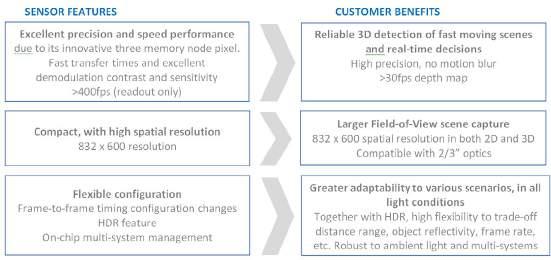
The three-tap pixel provides the ability to capture and store the information of the different phases needed to reconstruct the 3D map in one single frame, instead of the multiple frames
required with other indirect ToF technologies. This is particularly powerful in avoiding any motion blur in fast moving scenes. It’s similar to comparing a global shutter mode to a rolling shutter mode in 2D vision. We often compare Time-of-Flight sensors to CCD sensors since the complexity of the set-up requires a significant effort at system level to integrate the sensor and so the need to master the applications set-up becomes critical.
The three-tap pixel can capture all phases with a single train of light pulses, making optimal use of the light power. In this example, frame rate has been maintained, so average light power consumption is much lower. However, light power can be traded-off to get a higher frame rate or higher precision (through multiple acquisition). Based on our expertise in ToF CMOS sensors and from working closely with our customers, Teledyne e2v has gained solid experience in assessing the challenges inherent to ToF systems. In order to help our customers to shorten their time-to-market and get the best ToF system to fit their application requirements, we provide technology solutions ranging from CMOS image sensors and customized camera modules, right up to full system integration support. This includes a reference design of our evaluation platform, light & optics assessment, eye safety consideration, modelisation and simulations, algorithms and calibrations.
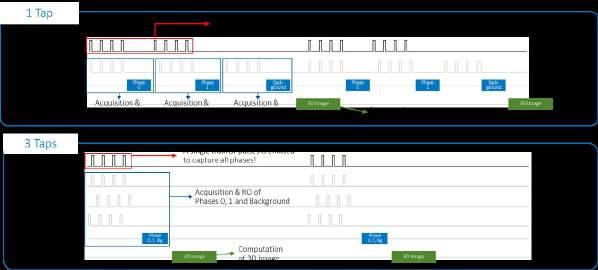
Figure 5. One-tap pixel vs Three-tap pixel illustration
Other benefits of the Hydra3D sensor are its flexibility in configuration and its multiple on-chip features. For instance, a powerful on-chip HDR feature combined with a high frame rate, and a flexible configuration allows you to trade-off between distance range, object reflectivity, frame rate, etc. as well as being robust to the ambient light. Or the unique on-chip feature for robust multiple ToF system operation that enables unsynchronized systems to work simultaneously without interfering with each other.
Figure 6. Teledyne-e2v ToF expertise and capabilities up to system level
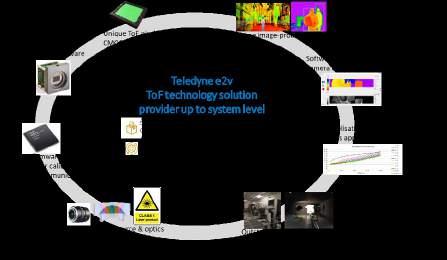
Key characteristics of the Hydra3D sensor: Summary
Time-of-Flight in the age of CCD adoption
Making Time-of-Flight image processing is much more complex than a conventional 2D vision system. It involves optics and a light system that will depend on several parameters (such as the sensor or the field-of-view, in-factory calibration, specific sensor configuration) to fit perfectly with the application requirements. As factories and distribution warehouse are increasingly automated, there is an increasing need for effective and autonomous industrial systems, particularly 3D vision for guided robots and machines (for object recognition, navigation, high speed and accuracy). Several 3D techniques exist, each with pros and cons, with the preferred technology, very much depending on the requirements of the application. All of these techniques are demanding and require high performance sensors with complex features.
Teledyne e2v has a successful track record with market leaders and offers a broad range of unique solutions, including 3D vision, to serve industrial markets such as factory automation, logistics and metrology applications. Our unique expertise in high performance CMOS image sensors (incorporating cutting-edge pixels and special features) coupled with over 10 years solid experience in ToF systems, enables us to help our customers to overcome the current challenges of 3D vision.
(The article is an original piece written by Teledyne e2v.)
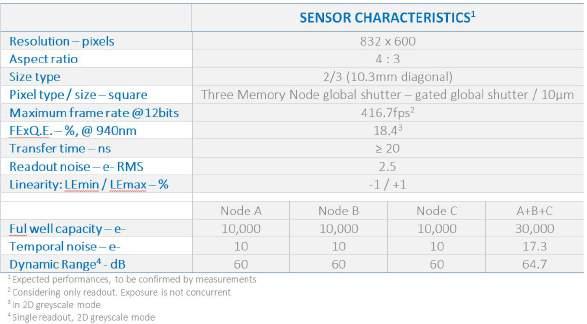
Elektrobit, SUSE’s Automotive-Grade Linux in China
Elektrobit (EB) has extended its collaboration with SUSE, the multinational, open-source software company, to provide car makers and Tier 1 suppliers in China with automotivegrade Linux. EB corbos Linux is an operating system for high-performance CPUs providing a basis for the latest AUTOSAR standard and will enable car makers to accelerate the development of cutting-edge software for next-gen E/E architecture. The collaboration brings together the automotive experience and expertise of EB with the IT infrastructure experience of SUSE, which pioneered Linux in the enterprise. SUSE Linux Enterprise is. EB corbos Linux is based on SUSE Linux Enterprise, and automotive customers will benefit from a robust, safe and reliable yet flexible solution that includes development, integration and deployment tools, software updates, and security patches for up to 15 years. EB corbos Linux together with EB corbos hypervisor provides a complete operating system and virtualization solution for Adaptive AUTOSAR development. EB was among the first to offer a commercially available software implementation of Adaptive AUTOSAR, and its scalable solutions are making it easier for car makers and Tier 1 suppliers to develop HPC systems.
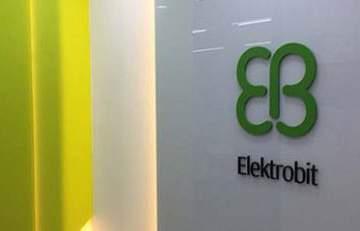
Hella Extended its Electromobility Conditions Hino Motors, REE Sign Business Alliance Deal
Hella has expanded its market position in electromobility. Its innovative power electronics ensure intelligent energy management and greater fuel efficiency. Back in 2007, the company launched the world’s first 12-volt voltage converter that supports the start/stop function in the vehicle. Since 2016, Hella has been enabling the trend towards mild hybridisation with 48-volt power electronics. The 48-volt DC/DC converters allow bidirectional energy transfer between 48-volt and 12-volt onboard networks and enable that the recuperation energy recovered during braking is made available to the 12-volt network again, thus enabling the energy to be used efficiently. In addition to the 48-volt DC/DC converters, the company also has a 48-volt PowerPack in its range, which combines power electronics plus battery management to monitor the lithium-ion battery. Hella has now also won an order for this from a German premium car manufacturer.
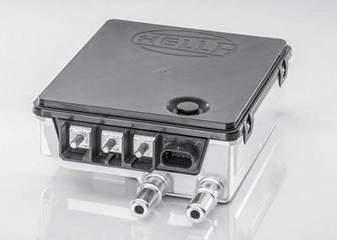
Hella develops high-voltage converters and innovative solutions for charging electric vehicles. This includes, for example, a highly efficient on-board charger optimised for weight and installation space. It offers the possibility of charging the vehicle and feeding energy from the vehicle battery back into the grid. Integrated Smart Charging functionalities also allow intelligent control of the grid load and thus compensate for overload peaks for the grid supply. Hino Motors and REE have signed a strategic business alliance agreement to realize their shared vision of “providing new value to society through next-

generation commercial mobility.” Hino and REE’s next-generation electric commercial mobility solutions are geared to improve quality of life on a global scale by lowering carbon emissions, minimizing strain on infrastructure, reducing congestion and allowing companies to better allocate resources.
The two companies will combine their advantages to realize this vision – Hino’s knowledge and technologies as a commercial vehicle manufacturer closely attuned to customer needs with REE’s innovative and highly competitive proprietary REEcornerTM EV technologies – and take on initiatives to create new value through next-generation commercial mobility solutions.
The next-generation commercial mobility solution to be jointly developed by Hino and REE will be comprised of a modular platform (Powered by REE) that will carry a customized Mobility Service Module on top. The Mobility Service Module – which will carry passengers, goods and deliver services – would address a wide variety of current and future applications aligned with customer requirements, aimed to provide new value to society, and will be enhanced with data-driven services. The companies will first work to develop hardware prototypes by FY 2022, while evaluating business models, engaging potential customers, and conducting demonstrations in parallel.









